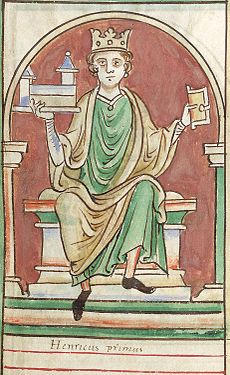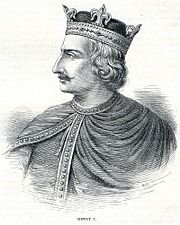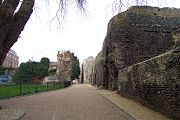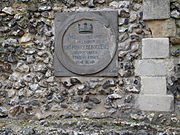
Henry I of England
Background to the schools Wikipedia
SOS Children, an education charity, organised this selection. Click here to find out about child sponsorship.
| Henry I Beauclerc | |
|---|---|
 |
|
| Miniature from illuminated Chronicle of Matthew Paris | |
|
|
|
| Reign | 3 August 1100 – 1 December 1135 |
| Coronation | 5 August 1100 |
| Predecessor | William II Rufus |
| Successor | Stephen of Blois ( de facto) Matilda of England ( de jure) |
|
|
|
| Reign | 1106 – 1 December 1135 |
| Predecessor | Robert II Curthose |
| Successor | Stephen of Blois |
| Consort | Matilda of Scotland m. 1100; dec. 1118 Adeliza of Louvain m. 1121; wid. 1135 |
| Issue | |
| Empress Matilda William Adelin |
|
| House | Norman dynasty |
| Father | William I the Conqueror |
| Mother | Matilda of Flanders |
| Burial | Reading Abbey, Berkshire |
Henry I (c. 1068/1069 – 1 December 1135) was the fourth son of William I the Conqueror. He succeeded his elder brother William II as King of England in 1100 and defeated his eldest brother, Robert Curthose, to become Duke of Normandy in 1106. He was called Beauclerc for his scholarly interests and Lion of Justice for refinements which he brought about in the administrative and legislative machinery of the time.
Henry's reign is noted for its political opportunism. His succession was confirmed while his brother Robert was away on the First Crusade and the beginning of his reign was occupied by wars with Robert for control of England and Normandy. He successfully reunited the two realms again after their separation on his father's death in 1087. Upon his succession he granted the baronage a Charter of Liberties, which formed a basis for subsequent challenges to rights of kings and presaged Magna Carta, which subjected the King to law.
The rest of Henry's reign was filled with judicial and financial reforms. He established the biannual Exchequer to reform the treasury. He used itinerant officials to curb abuses of power at the local and regional level, garnering the praise of the people. The differences between the English and Norman populations began to break down during his reign and he himself married a daughter of the old English royal house. He made peace with the church after the disputes of his brother's reign, but he could not smooth out his succession after the disastrous loss of his eldest son William in the wreck of the White Ship. His will stipulated that he was to be succeeded by his daughter, the Empress Matilda, but his stern rule was followed by a period of civil war known as the Anarchy.
Early life
Henry was born between May 1068 and May 1069, probably in Selby in Yorkshire. His mother, Queen Matilda, was descended from Alfred the Great (but not through the main West Saxon Royal line). Queen Matilda named the infant Prince Henry, after her uncle, Henry I of France. As the youngest son of the family, he was almost certainly expected to become a Bishop and was given rather more extensive schooling than was usual for a young nobleman of that time. The Chronicler William of Malmesbury asserts that Henry once remarked that an illiterate King was a crowned ass. He was certainly the first Norman ruler to be fluent in the English language.
William I's second son Richard was killed in a hunting accident in 1081, so William bequeathed his dominions to his three surviving sons in the following manner:
- Robert received the Duchy of Normandy and became Duke Robert II
- William Rufus received the Kingdom of England and became King William II
- Henry Beauclerc received 5,000 pounds in silver
The Chronicler Orderic Vitalis reports that the old King had declared to Henry: "You in your own time will have all the dominions I have acquired and be greater than both your brothers in wealth and power."
Henry tried to play his brothers off against each other but eventually, wary of his devious manoeuvring, they acted together and signed an Accession Treaty. This sought to bar Prince Henry from both Thrones by stipulating that if either King William or Duke Robert died without an heir, the two dominions of their father would be reunited under the surviving brother.
Seizing the throne of England
| Normans |
|---|
 William the Conqueror invades England
|
|
|
Henry I
|
|
| Monarchy of the United Kingdom |
When, on 2 August 1100, William II was killed by an arrow in yet another hunting accident in the New Forest, Duke Robert had not yet returned from the First Crusade. His absence allowed Prince Henry to seize the Royal Treasury at Winchester, Hampshire, where he buried his dead brother. There are suspicions that, on hearing that Robert was returning alive from his crusade with a new bride, Henry decided to act and arranged the murder of William by Walter Tirel. Thus he succeeded to the throne of England, guaranteeing his succession in defiance of William and Robert's earlier agreement. Henry was accepted as King by the leading Barons and was crowned three days later on 5 August at Westminster Abbey. He secured his position among the nobles by an act of political appeasement: he issued a Charter of Liberties which is considered a forerunner of the Magna Carta.
First marriage
On 11 November 1100 Henry married Edith, daughter of King Malcolm III of Scotland. Since Edith was also the niece of Edgar Atheling and the great-granddaughter of Edward the Confessor's paternal half-brother Edmund Ironside, the marriage united the Norman line with the old English line of Kings. The marriage greatly displeased the Norman Barons, however, and as a concession to their sensibilities Edith changed her name to Matilda upon becoming Queen. The other side of this coin, however, was that Henry, by dint of his marriage, became far more acceptable to the Anglo-Saxon populace.
The chronicler William of Malmesbury described Henry thus: "He was of middle stature, greater than the small, but exceeded by the very tall; his hair was black and set back upon the forehead; his eyes mildly bright; his chest brawny; his body fleshy."
Conquest of Normandy
In the following year, 1101, Robert Curthose, Henry's eldest brother, attempted to seize the crown by invading England. In the Treaty of Alton, Robert agreed to recognise his brother Henry as King of England and return peacefully to Normandy, upon receipt of an annual sum of 2000 silver marks, which Henry proceeded to pay.
In 1105, to eliminate the continuing threat from Robert and the drain on his fiscal resources from the annual payment, Henry led an expeditionary force across the English Channel.
Battle of Tinchebray
On the morning of 28 September 1106, exactly 40 years after William had made his way to England, the decisive battle between his two surviving sons, Robert Curthose and Henry Beauclerc, took place in the small village of Tinchebray. This combat was totally unexpected and unprepared. Henry and his army were marching south from Barfleur on their way to Domfront and Robert was marching with his army from Falaise on their way to Mortain. They met at the crossroads at Tinchebray and the running battle which ensued was spread out over several kilometres. The site where most of the fighting took place is the village playing field today. Towards evening Robert tried to retreat but was captured by Henry's men at a place three kilometres (just under two miles) north of Tinchebray where a farm named "Prise" (taken) stands today on the D22 road. The tombstones of three knights are nearby on the same road.
King of England and Ruler of Normandy
After Henry had defeated his brother's Norman army at Tinchebray he imprisoned Robert, initially in the Tower of London, subsequently at Devizes Castle and later at Cardiff. One day whilst out riding Robert attempted to escape from Cardiff but his horse was bogged down in a swamp and he was recaptured. To prevent further escapes Henry had Robert's eyes burnt out. Henry appropriated the Duchy of Normandy as a possession of the Kingdom of England and reunited his father's dominions. Even after taking control of the Duchy of Normandy he didn't take the title of Duke, he chose to control it as the King of England.
In 1113, Henry attempted to reduce difficulties in Normandy by betrothing his eldest son, William Adelin, to the daughter of Fulk of Jerusalem (also known as Fulk V), Count of Anjou, then a serious enemy. They were married in 1119. Eight years later, after William's untimely death, a much more momentous union was made between Henry's daughter, (the former Empress) Matilda and Fulk's son Geoffrey Plantagenet, which eventually resulted in the union of the two Realms under the Plantagenet Kings.
Activities as a King
Henry's need for finance to consolidate his position led to an increase in the activities of centralized government. As King, Henry carried out social and judicial reforms, including:
- issuing the Charter of Liberties
- restoring the laws of Edward the Confessor.
Between 1103 and 1107 Henry was involved in a dispute with Anselm, the Archbishop of Canterbury, and Pope Paschal II in the investiture controversy, which was settled in the Concordat of London in 1107. It was a compromise. In England, a distinction was made in the King's chancery between the secular and ecclesiastical powers of the prelates. Employing the distinction, Henry gave up his right to invest his bishops and abbots, but reserved the custom of requiring them to come and do homage for the " temporalities" (the landed properties tied to the episcopate), directly from his hand, after the bishop had sworn homage and feudal vassalage in the ceremony called commendatio, the commendation ceremony, like any secular vassal.
Henry was also known for some brutal acts. He once threw a treacherous burgher named Conan Pilatus from the tower of Rouen; the tower was known from then on as "Conan's Leap". In another instance that took place in 1119, Henry's son-in-law, Eustace de Pacy, and Ralph Harnec, the constable of Ivry, exchanged their children as hostages. When Eustace blinded Harnec's son, Harnec demanded vengeance. King Henry allowed Harnec to blind and mutilate Eustace's two daughters, who were also Henry's own grandchildren. Eustace and his wife, Juliane, were outraged and threatened to rebel. Henry arranged to meet his daughter at a parley at Breteuil, only for Juliane to draw a crossbow and attempt to assassinate her father. She was captured and confined to the castle, but escaped by leaping from a window into the moat below. Some years later Henry was reconciled with his daughter and son-in-law.
Legitimate children
He had two children by Matilda (Edith), who died on 1 May 1118 at the palace of Westminster. She was buried in Westminster Abbey.
- Matilda. (c. February 1102 – 10 September 1167). She married firstly Henry V, Holy Roman Emperor, and secondly, Geoffrey V, Count of Anjou, having issue by the second.
- William Adelin, ( 5 August 1103 – 25 November 1120). He married Matilda (d.1154), daughter of Fulk V, Count of Anjou.
Second marriage
On 29 January 1121 he married Adeliza, daughter of Godfrey I of Leuven, Duke of Lower Lotharingia and Landgrave of Brabant, but there were no children from this marriage. Left without male heirs, Henry took the unprecedented step of making his barons swear to accept his daughter Empress Matilda, widow of Henry V, the Holy Roman Emperor, as his heir.
Death and legacy
Henry visited Normandy in 1135 to see his young grandsons, the children of Matilda and Geoffrey. He took great delight in his grandchildren, but soon quarrelled with his daughter and son-in-law and these disputes led him to tarry in Normandy far longer than he originally planned.
Henry died on 1 December 1135 of food poisoning from eating "a surfeit of lampreys" (of which he was excessively fond) at Saint-Denis-en-Lyons (now Lyons-la-Forêt) in Normandy. His remains were sewn into the hide of a bull to preserve them on the journey, and then taken back to England and were buried at Reading Abbey, which he had founded fourteen years before. The Abbey was destroyed during the Protestant Reformation. No trace of his tomb has survived, the probable site being covered by St James' School. Nearby is a small plaque and a large memorial cross stands in the adjoining Forbury Gardens.
Although Henry's barons had sworn allegiance to his daughter as their Queen, her gender and her remarriage into the House of Anjou, an enemy of the Normans, allowed Henry's nephew Stephen of Blois, to come to England and claim the throne with popular support.
The struggle between the former Empress and Stephen resulted in a long civil war known as the Anarchy. The dispute was eventually settled by Stephen's naming of Matilda's son, Henry Plantagenet, as his heir in 1153.
Illegitimate children
King Henry is famed for holding the record for the largest number of acknowledged illegitimate children born to any English king, with the number being around 20 or 25. He had many mistresses, and identifying which mistress is the mother of which child is difficult. His illegitimate offspring for whom there is documentation are:
- Robert, 1st Earl of Gloucester. Often, said to have been a son of Sybil Corbet.
- Maud FitzRoy, married Conan III, Duke of Brittany
- Constance FitzRoy, married Richard de Beaumont
- Mabel FitzRoy, married William III Gouet
- Aline FitzRoy, married Matthieu I of Montmorency
- Gilbert FitzRoy, died after 1142. His mother may have been a sister of Walter de Gand.
- Emma, born c. 1138; married Gui de Laval, Lord Laval. [Uncertain, born 2 years after Henry died.]
With Edith
- Matilda, married in 1103 Count Rotrou II of Perche. She perished 25 Nov 1120 in the wreck of the White Ship. She left two daughters; Philippa who married Helie of Anjou (son of Fulk V) and Felice.
With Gieva de Tracy
- William de Tracy
With Ansfride
Ansfride was born c. 1070. She was the wife of Anskill of Seacourt, at Wytham in Berkshire (now Oxfordshire).
- Juliane de Fontevrault (born c. 1090); married Eustace de Pacy in 1103. She tried to shoot her father with a crossbow after King Henry allowed her two young daughters to be blinded.
- Fulk FitzRoy (born c. 1092); a monk at Abingdon.
- Richard of Lincoln (c. 1094 – 25 November 1120); perished in the wreck of the White Ship.
With Sybil Corbet
Lady Sybilla Corbet of Alcester was born in 1077 in Alcester in Warwickshire. She married Herbert FitzHerbert, son of Herbert 'the Chamberlain' of Winchester and Emma de Blois. She died after 1157 and was also known as Adela (or Lucia) Corbet. Sybil was definitely mother of Sybil and Rainald, possibly also of William and Rohese. Some sources suggest that there was another daughter by this relationship, Gundred, but it appears that she was thought as such because she was a sister of Reginald de Dunstanville but it appears that that was another person of that name who was not related to this family.
- Sybilla de Normandy, married Alexander I of Scotland.
- William Constable, born before 1105. Married Alice (Constable); died after 1187.
- Reginald de Dunstanville, 1st Earl of Cornwall.
- Gundred of England (1114–46), married 1130 Henry de la Pomeroy, son of Joscelin de la Pomerai.
- Rohese of England, born 1114; married William de Tracy (b. 1040 in Normandy, France d. 1110 in Barnstaple, Devon, England)son of Turgisus de Tracy. They married in 1075. They had four children 1)Turgisus II de Tracy b. 1066, 2) Henry de Tracy b. 1068, 3) Gieva de Tracy b. 1068 d. 1100, 4)Henry of Barnstaple Tracy b. 1070 d.1170.
With Edith FitzForne
- Robert FitzEdith, Lord Okehampton, (1093–1172) married Dame Maud d'Avranches du Sap. They had one daughter, Mary, who married Renaud, Sire of Courtenay (son of Miles, Sire of Courtenay and Ermengarde of Nevers).
- Adeliza FitzEdith. Appears in charters with her brother Robert.
With Princess Nest
Nest ferch Rhys was born about 1073 at Dinefwr Castle, Carmarthenshire, the daughter of Prince Rhys ap Tewdwr of Deheubarth and his wife, Gwladys ferch Rhywallon. She married, in 1095, to Gerald de Windsor (aka Geraldus FitzWalter) son of Walter FitzOther, Constable of Windsor Castle and Keeper of the Forests of Berkshire. She had several other liaisons — including one with Stephen of Cardigan, Constable of Cardigan (1136) — and subsequently other illegitimate children. The date of her death is unknown.
- Henry FitzRoy, 1103-1158.
With Isabel de Beaumont
Isabel (Elizabeth) de Beaumont (after 1102 – after 1172), daughter of Robert de Beaumont, sister of Robert de Beaumont, 2nd Earl of Leicester. She married Gilbert de Clare, 1st Earl of Pembroke, in 1130. She was also known as Isabella de Meulan.
- Isabel Hedwig of England
- Matilda FitzRoy, abbess of Montvilliers, also known as Montpiller
Ancestors
|
|
|
|
|
|
|
|
|
|
|
|
|
|
|
|
|
|
|
|
16. Richard I, Duke of Normandy | |||||||||||||||
|
|
||||||||||||||||
|
|
|
|
|
|
||||||||||||
|
|
8. Richard II, Duke of Normandy |
|
||||||||||||||
|
|
||||||||||||||||
|
|
|
|
|
|
|
|
|
|||||||||
|
|
17. Gunnora, Duchess of Normandy | |||||||||||||||
|
|
||||||||||||||||
|
|
|
|
|
|
||||||||||||
|
|
4. Robert I, Duke of Normandy |
|
||||||||||||||
|
|
||||||||||||||||
|
|
|
|
|
|
|
|
|
|
|
|
||||||
|
|
18. Conan I of Rennes | |||||||||||||||
|
|
||||||||||||||||
|
|
|
|
|
|
||||||||||||
|
|
9. Judith of Brittany |
|
||||||||||||||
|
|
||||||||||||||||
|
|
|
|
|
|
|
|
|
|||||||||
|
|
19. Ermengarde of Anjou | |||||||||||||||
|
|
||||||||||||||||
|
|
|
|
|
|
||||||||||||
|
|
2. William I of England |
|
||||||||||||||
|
|
||||||||||||||||
|
|
|
|
|
|
|
|
|
|
|
|
|
|
|
|||
|
|
10. Fulbert of Falaise |
|
||||||||||||||
|
|
||||||||||||||||
|
|
|
|
|
|
|
|
|
|||||||||
|
|
5. Herleva |
|
||||||||||||||
|
|
||||||||||||||||
|
|
|
|
|
|
|
|
|
|
|
|
||||||
|
|
1. Henry I of England |
|
||||||||||||||
|
|
||||||||||||||||
|
|
|
|
|
|
|
|
|
|
|
|
|
|
|
|
|
|
|
|
24. Arnulf II, Count of Flanders | |||||||||||||||
|
|
||||||||||||||||
|
|
|
|
|
|
||||||||||||
|
|
12. Baldwin IV, Count of Flanders |
|
||||||||||||||
|
|
||||||||||||||||
|
|
|
|
|
|
|
|
|
|||||||||
|
|
25. Rozala of Italy | |||||||||||||||
|
|
||||||||||||||||
|
|
|
|
|
|
||||||||||||
|
|
6. Baldwin V, Count of Flanders |
|
||||||||||||||
|
|
||||||||||||||||
|
|
|
|
|
|
|
|
|
|
|
|
||||||
|
|
26. Frederick of Luxembourg | |||||||||||||||
|
|
||||||||||||||||
|
|
|
|
|
|
||||||||||||
|
|
13. Ogive of Luxembourg |
|
||||||||||||||
|
|
||||||||||||||||
|
|
|
|
|
|
|
|
|
|||||||||
|
|
3. Matilda of Flanders |
|
||||||||||||||
|
|
||||||||||||||||
|
|
|
|
|
|
|
|
|
|
|
|
|
|
|
|||
|
|
28. Hugh Capet | |||||||||||||||
|
|
||||||||||||||||
|
|
|
|
|
|
||||||||||||
|
|
14. Robert II of France |
|
||||||||||||||
|
|
||||||||||||||||
|
|
|
|
|
|
|
|
|
|||||||||
|
|
29. Adelaide of Aquitaine | |||||||||||||||
|
|
||||||||||||||||
|
|
|
|
|
|
||||||||||||
|
|
7. Adela of France |
|
||||||||||||||
|
|
||||||||||||||||
|
|
|
|
|
|
|
|
|
|
|
|
||||||
|
|
30. William I of Provence | |||||||||||||||
|
|
||||||||||||||||
|
|
|
|
|
|
||||||||||||
|
|
15. Constance of Arles |
|
||||||||||||||
|
|
||||||||||||||||
|
|
|
|
|
|
|
|
|
|||||||||
|
|
31. Adelaide of Anjou | |||||||||||||||
|
|
||||||||||||||||
|
|
|
|
|
|
||||||||||||




